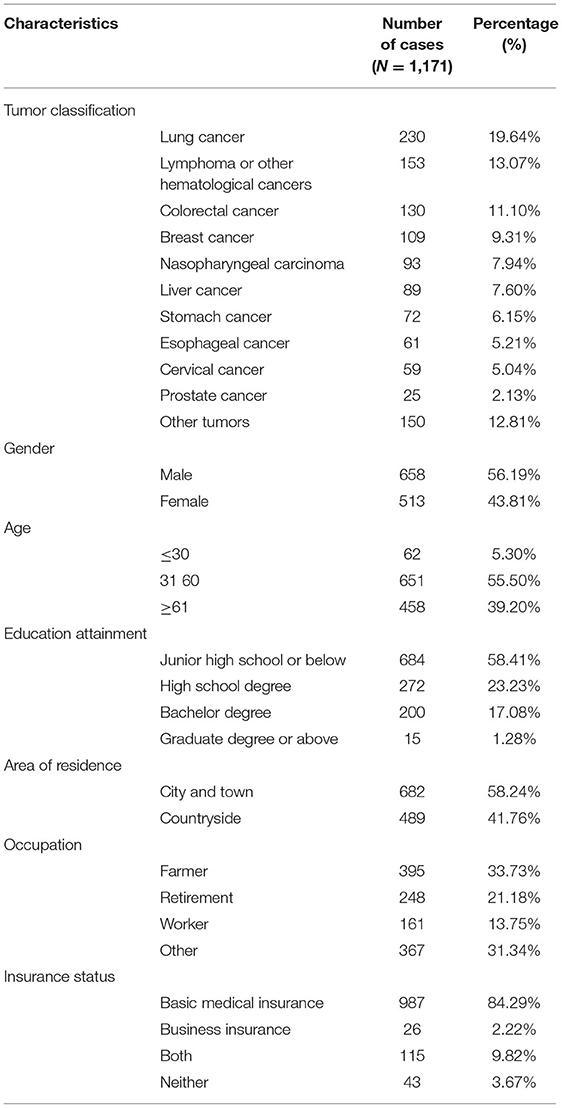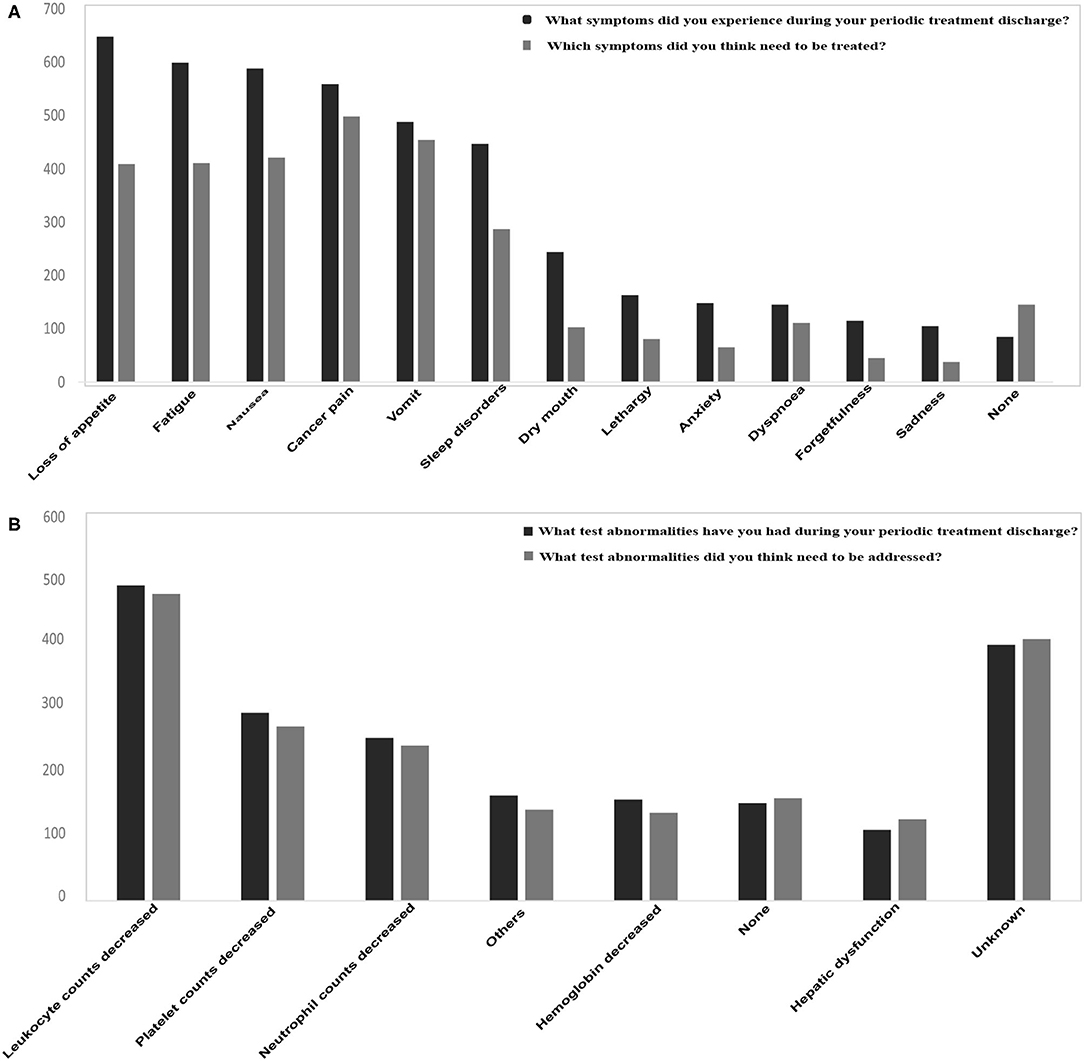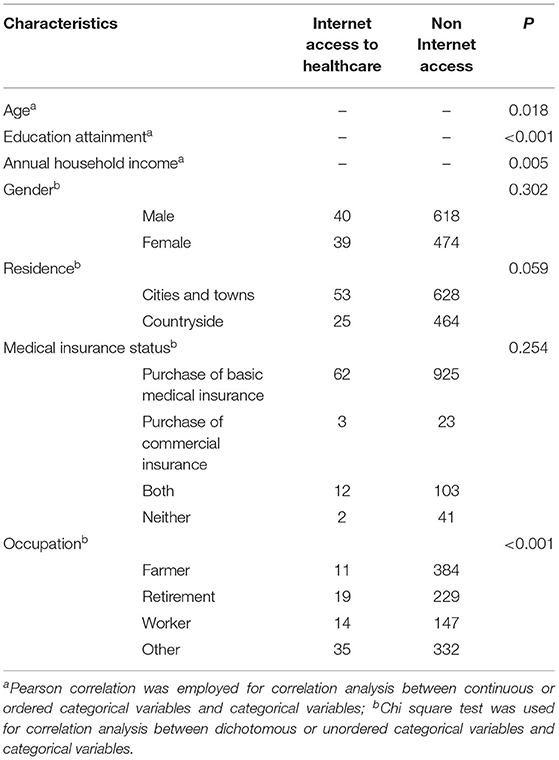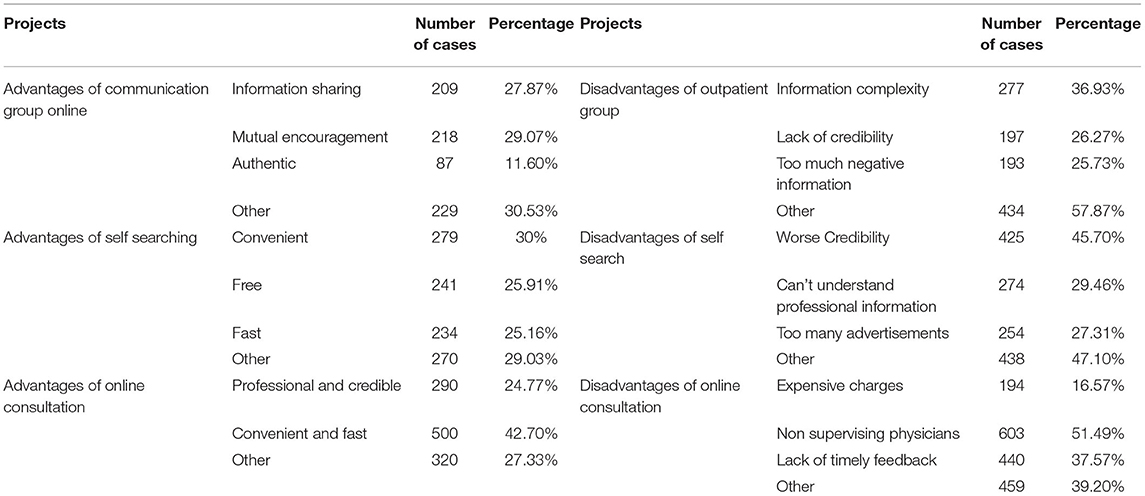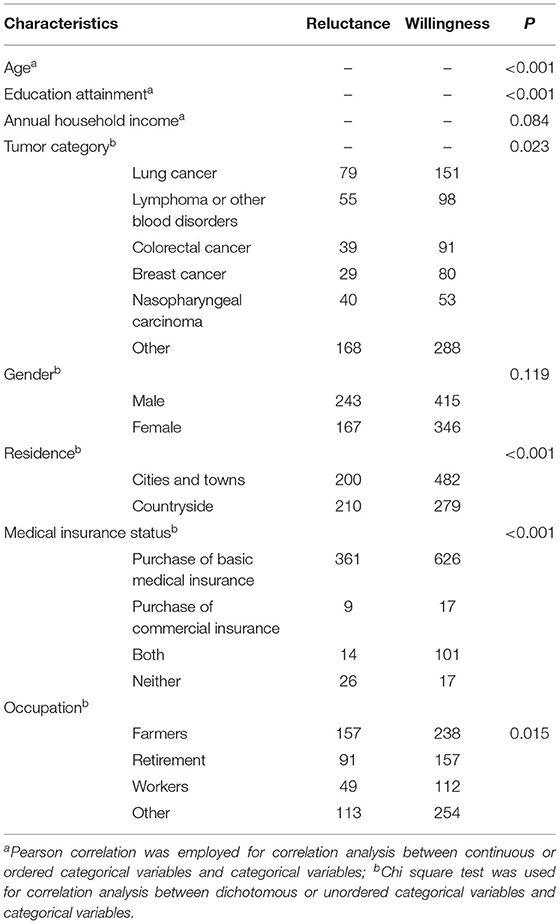- 1Department of Lung Cancer Center, West China Hospital Sichuan University, Chengdu, China
- 2Department of Oncology, First People's Hospital of Jintang County, Chengdu, China
- 3Department of Cancer Center, Yibin Second People's Hospital, Yibin, China
- 4Department of Oncology, Nanchong Central Hospital, Nanchong, China
- 5Department of Oncology, Hospital of Zhi Zhong Zhi Zhou & Cancer Hospital of Neijiang, Neijiang, China
- 6Department of Oncology, Zigong Fourth People's Hospital, Zi Gong, China
- 7Department of Head and Neck Oncology, West China Hospital, Sichuan University, Chengdu, China
Objective: To explore the current situation of the out-of-hospital management of patients with cancer and evaluate the feasibility of Internet medical intervention outside the hospital in China.
Methods: The questionnaire was designed based on the investigators' clinical experience, literature data, and the Anderson Symptom Scale, and adopted a cross sectional survey method.
Results: Totally 1,171 qualified questionnaires were analyzed. The results showed that 92.7% of patients with cancer experienced varying degrees of out-of-hospital symptoms after treatment, and a third of them needed clinical intervention. Abnormal blood test results outside the hospital were basically consistent with the events that occurred during the hospitalization. One third of patients with cancer could not identify abnormal results. The primary approaches to solve these abnormalities were to seek guidance from the physician in charge or from nearby hospitals, but only 6.75% patients sought help online. More than half of the life or work of patients with cancer are still greatly affected under the current management model. 92% of respondents required medical help outside the hospital, and 65% ones were willing to pay for the out-of-hospital management.
Conclusions: Out-of-hospital management model needs to be improved. Most users are willing to accept Internet cancer management with fees. The survey has a positive effect on guiding future Internet cancer management practices in China to a certain extent.
Background
Cancer management has been a heavy burden on the global healthcare system for a long time. The latest International Agency for Research on Cancer (IARC) GLOBOCAN cancer statistics reported that there were 19.29 million new cancer cases worldwide in 2020, of which 4.57 million new cancer cases were in China, accounting for 23.7% of the total, and 9.96 million deaths worldwide in 2020, of which 3 million deaths were in China, accounting for 30% of the total deaths (1). In addition, with the rapid development of anticancer drugs and medical technology, targeted therapy and immunotherapy have shown amazing curative effect, leading to the improvement of overall survival of patients with cancer. In 2020 alone, nearly 10 million cancer cases worldwide survived, and the cancer population continued to rise. Compared with other chronic diseases, the condition of patients with cancer tends to change greatly, resulting in more difficult disease management. Given that relying on the traditional cancer management remains an unmet clinical need, it is urgent to further explore new management models (2, 3).
The Internet is increasingly becoming an indispensable source of information for patients with cancer (4, 5). Satterlund et al. (6) reported that 49% of patients with breast cancer used the Internet for medical information up to 8 months after diagnosis, 40% of the patients used the Internet up to 16 months, and the Internet continued to provide medical information support for patients even until the end of the whole treatment. One study in Netherlands indicated that the proportion of patients with cancer using the disease related Internet increased dramatically from 60% in 2005 to 85% in 2017, and 47% of patients with cancer thought that the Internet was an important source of getting disease information (7). Additionally, Internet healthcare further expanded the content of services for patients including health education online, electronic health files, online consultation, online drug purchase, and other forms of health management services (8). Increasing online applications provided comprehensive health care services for patients with chronic diseases such as hypertension and diabetes, and they could also function in the field of postoperative follow up (4, 9–11). Furthermore, a number of prospective randomized controlled clinical trials abroad showed that patients with cancer accepted out-of-hospital follow up management with the help of Internet to report post-treatment reactions and symptoms, with significant benefits including emergency attendance reduction, improvement of life quality of patients with cancer, and longer overall survival (12–17). In this scenario, many countries are trying to build and improve out-of-hospital Internet management systems or applications suitable for most patients with cancer (18, 19).
Nowadays, the Internet is developing vigorously and has penetrated into the daily life of Chinese public. However, Chinese Internet medical services system of cancer management started late, and few reports of out-of-hospital management were issued, leading to a lack of management experience. Based on the above background, we performed this investigation to initially explore the current situation of out-of-hospital management of patients with cancer in Sichuan Province, China and analyze the cognition of Internet medical services in cancer management so as to provide some basis for better out-of-hospital management.
Materials and Methods
Study Population
A cross sectional study was conducted by convenience sampling method, and a total of 1,473 nonprimary inpatient patients with cancer meeting the criteria were selected from the departments of medical oncology of 13 tertiary hospitals in 10 localities in Sichuan Province from December 2020 to February 2021, respectively, for a web based questionnaire survey. These 13 hospitals were: Yibin Second People's Hospital, Nanchong Central Hospital, Xichang Yi Hospital, Panzhihua College Hospital, Chengdu Third People's Hospital, Chengdu Fifth People's Hospital, The First Hospital of Sichuan North Medical College, Neijiang Cancer Hospital, Suining Central Hospital, Zigong First People's Hospital, Zigong Fourth People's Hospital, Meishan Cancer Hospital and West China Hospital of Sichuan University. The main inclusion criteria of this study were: (i) 18 years old or older; (ii) with a clear histological or cytological diagnosis of malignancy and having had antitumor treatment (radiotherapy, chemotherapy, targeted therapy, or immunotherapy); (iii) with clear consciousness, normal comprehension, and good compliance to complete this questionnaire.
Questionnaire Development
The questionnaire was designed through the researchers' clinical experience, expert evaluation as well as literature data, in which questions about patients' symptoms were designed with reference to the Anderson Symptom Scale. The final version of the questionnaire was revised repeatedly, and the electronic version was designed on the platform of “Questionnaire Star”.
Data Collection (Questionnaire)
Specially trained investigators went to the wards of above mentioned major hospitals to assist the respondents to complete the questionnaire and answer patients' questions professionally.
Quality Control
The subject principal officer conducted this investigation as a quality control officer, responsible for all questionnaires. Before carrying out, the subject research team performed a unified training of questionnaire collection personnel. After carrying out, the quality controller reviewed and checked the questionnaire [Questionnaire exclusion criteria were the following: (i) questionnaire filling time shorter than 120 s; (ii) questionnaire filling time beyond 8:00 am−10:00 pm].
Statistical Methods
All questionnaires were downloaded from Questionnaire Star in excel, and the software Excel was used for initial data screening. SPSS 25.0 software was used for data analysis. The results were generally expressed in frequency numbers and percentages. Chi square test and Pearson correlation were performed according to the type of variables with p < 0.05 as a statistically significant difference.
Ethical Consideration
The study protocol was reviewed and approved by the ethical review committees. All patients were fully informed, and they signed a written informed consent prior to the start of the study.
Results
Recovery and Reliability Test
From December 15, 2020 to February 24, 2021, a total of 1,171 (81.5%) valid questionnaires were analyzed after excluding 302 (20.5%) unqualified questionnaires. Questionnaire reliability and validity were analyzed by SPSS 25. The Cronbach's alpha coefficient was 0.747 (low reliability: α < 0.35; medium reliability: 0.35 < α < 0.70; high reliability: α >0.70) and the value of KMO was 0.805 (KMO > 0.9, very suitable for factor analysis; 0.8 < KMO < 0.9, suitable; >0.7, acceptable; = 0.6, with very poor effect; < 0.5, not suitable for factor analysis). The results indicated that the questionnaire was suitable for factor analysis and the overall validity was good.
Basic Information
The median age of 1,171 patients was 57 years, with 6.2% in the 18–30 age group, 55.5% in the 31–60 age group, and 39.2% in the ≥61 age group. There were slightly more men than women. Those with junior high school education or below accounted for 58.41%. The proportion of those living in urban areas was 58.24%, and the types of diseases in this study were, in descending order, lung cancer, lymphoma or hematological disease, colorectal cancer, breast cancer, nasopharyngeal cancer, liver cancer, gastric cancer, and esophageal cancer. There were 96% of the survey respondents with medical insurance, the vast majority of whom had only basic medical insurance, among whom only 2.22% had commercial insurance, and 9.82% of patients had both insurance (Table 1).
Patients' Out-of-Hospital Symptoms and Examination Abnormalities
According to the results, 92.74% of patients presented with various treatment or disease related out-of-hospital symptoms. The correlation analysis showed that those were mainly related to cancer type (p = 0.007), age (p < 0.001), and annual household income (p = 0.026), whereas gender, residence, health insurance status, occupation, and education attainment were not correlated (p > 0.05). Also, 87.62% of the patients thought that these symptoms needed to be treated. In terms of symptoms, the incidence exceeded 50%, including loss of appetite, fatigue and nausea, and 30–50% of the symptoms included pain, vomiting, and sleep disturbances. The proportion of patients with abnormal tests in routine out-of-hospital examinations was 53.29%, and 33.82% of patients were not sure of their test results or had no test results. Patients' attitudes toward different symptoms were different, for example, most patients thought that treatment was needed when they experienced pain and vomiting, whereas when symptoms such as dry mouth, fatigue, nausea, lethargy, and depression occurred, a considerable number of patients believed that treatment was not required (Figure 1A). However, when abnormal test indicators appeared, most patients thought that active intervention was required (Figure 1B). These abnormalities had an impact on the lives of 93.68% of patients, and 39.2% of them believed that they had a significant impact on their lives. At last, 92% of the respondents required out-of-hospital medical help, including symptom control (76.69%), interpretation of test reports (61.14%), dietary guidance (45.26%), sleep assistance (34.81%), and psychological counseling (25.36%).
Internet Medical Use and Correlation Analysis
The survey showed that when these outpatients wanted medical help, the nearby hospitals and their treating doctors were still main choices of them, except for 11.87% of cases who handled the problem by themselves, and only 6.75% of cases who sought help from the Internet. The main forms were as follows: searching for medical content through search engines, asking other patients for solutions through social media, and seeking advice from nonsupervised physicians on the Internet. The majority (78.57%) of patients felt that seeking guidance from a competent physician was the most helpful way to solve their problem, whereas 14.09% of patients felt that going to the nearest doctor would be the most helpful, and only 1.88% approved of online medical help. The survey revealed that patients contacted their supervising physicians in a variety of ways, with the highest percentage making outpatient registration (64.22%) or going directly to the ward (58.5%). Correlation analysis showed that the use of Internet healthcare services was correlated with age (p = 0.018), education (p < 0.001), annual household income (p < 0.01), and occupation (p < 0.001), and not with gender (p = 0.302), residence (p = 0.059), or health insurance status (p = 0.254) (Table 2).
Analysis of Cancer Patients' Awareness of Internet Healthcare and Correlations
As shown in Figure 2A, the public daily used the Internet mainly for shopping (15.14%), entertainment (12.66%), and chatting (20.52%), while only 5.41% used it in relation to e-healthcare, with correlations including age (p< 0.001), education (p < 0.001), and annual household income (p< 0.001). The current medicine related services on the Internet were mainly categorized into three types: social communication groups online established by patients spontaneously, the use of search engines, and Internet medical consultation services. The survey revealed that patients considered the main advantages of communication groups as information sharing (27.87%), mutual comfort, and encouragement (29.07%), as well as the disadvantages mainly included cumbersome information (36.93%), low credibility of content (26.27%), and too much negative information (25.73%). The main advantages of self searching were convenient (30%), free of charge (25.91%), and fast (25.16%), while the disadvantages included worse credibility (45.7%), too much professionalism (29.46%), and too many advertisements (27.31%). The main advantages of online consultation were mainly convenience (42.7%) and high credibility (24.77%), and the disadvantages mainly included no timely feedback (37.57%), improper judgement on their condition from the consultation by non-supervisory doctors (51.49%), and highly expensive fees (16.57%) (Table 3). In addition, the study showed that 65% of the respondents were willing to pay the fees for Internet medical intervention for out-of-hospital management, requiring more out-of-hospital medical help (Figure 2B). Further correlation analysis showed that the correlation of willingness to pay the fees for Internet healthcare services included tumor category (p = 0.023), age (p < 0.001), area of residence (p < 0.001), education (p < 0.001), health insurance status (p < 0.001), and occupation (p = 0.015), but not gender (p = 0.119) and annual household income (p = 0.084) (Table 4).
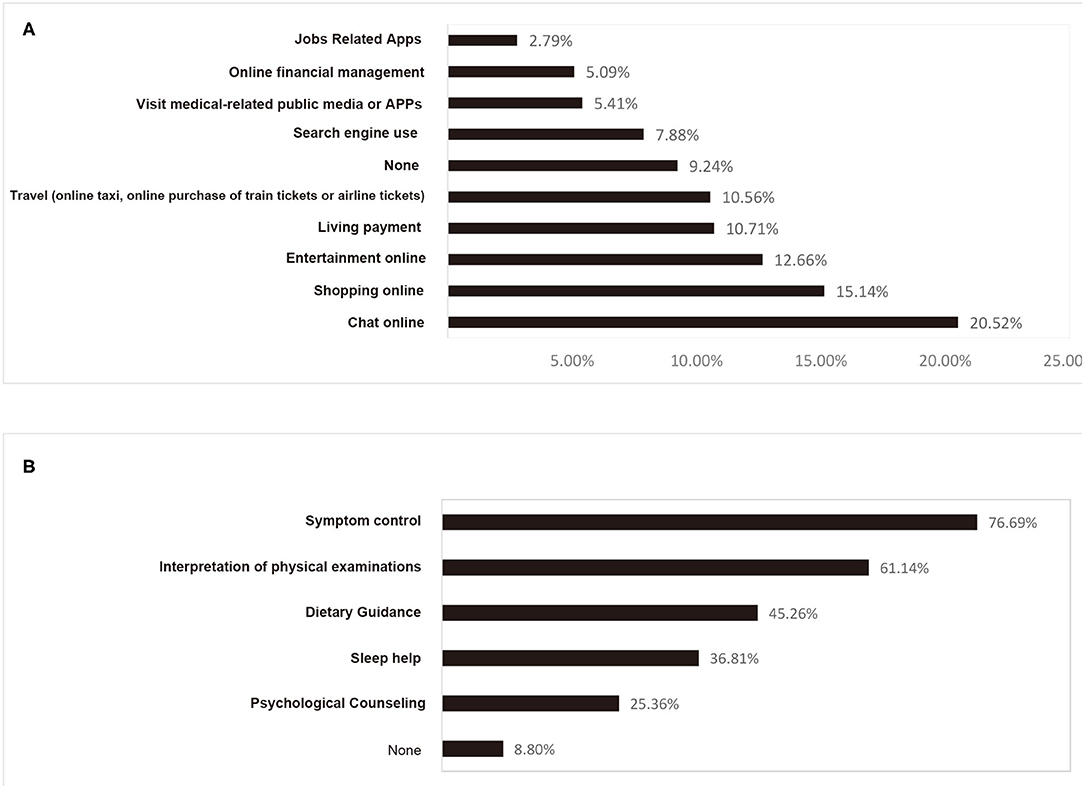
Figure 2. Proportion of the public using the Internet in various aspects (A) and the medical needs that patients expect outside the hospital (B).
Discussion
This study investigated the out-of-hospital conditions of patients with cancer in 13 large scale hospitals in Sichuan Province and found that up to 92.7% of patients with cancer still had different degrees of out-of-hospital symptoms after the treatment, and 53.3% of patients had abnormal test indicators. Of note, up to one third of the patients did not understand their test results or they did not know how to monitor it. These anomalies affected the life of most patients with cancer, and also 92% of respondents expected to receive appropriate out-of-hospital medical help.
Patients with cancer have significant differences in cognition of disease related symptoms and abnormal indicators outside the hospital. Most patients believe that vomiting, pain, virtually all of test abnormalities and so on need to be intervened, while loss of appetite, mood abnormalities, and insomnia symptoms do not need too much attention, which is quite different from the understanding of oncologists. Oncologists suggest that many of the test abnormalities are not necessarily required for special treatment, while symptoms such as loss of appetite and mood abnormalities are considered to require adequate attention. Therefore, if the nonhospital patients are not well managed, it may lead to unnecessary or inadequate intervention, ultimately affecting the treatment effectiveness and the quality of life of the patient. Miller et al. (20) believed that good cancer management can improve the condition of the patients including psychological, behavioral, and physical aspects. Moreover, Basch et al. (17) designed the out-of-hospital management app (Application) for patients with cancer and conducted prospective randomized controlled clinical trials, and the results revealed that based on patients reporting symptoms via the Internet, cancer out-of-hospital follow up management not only improved the patient survival quality, but also increased the overall survival. An observational study for patients with breast cancer in China also observed that Internet users satisfied with Internet information had a longer disease-free life (21). Interestingly, we also found that patients tend to report that nausea makes them more miserable, but vomiting is more likely to require intervention. Also, there are some differences between drowsy and fatigue. Drowsy tends to reflect their mental state, while fatigue tends to reflect their physical energy. The causes of the two symptoms are different: drowsy may be caused by an adverse reaction to a chemical agent and fatigue may be caused by hypoglycemia, hypokalemia, leukopenia, etc. People traditionally think that it is common to associate nausea with vomiting. However, in fact, there is definitely a difference between these symptoms, which is consistent with clinical observation from oncologists. Taken together, the Internet plays a non-negligible role in cancer management.
Our work also observed that about 90% of patients with cancer in Sichuan used the Internet on a routine basis, and only 5.41% of them daily used the Internet for medical help, and they are mainly young and highly educated. Other studies have also reported a clear correlation between online search for tumor information and their age and educational attainment in patients with breast cancer (11, 21). The main reasons why patients remain skeptical about the use of Internet medical information include: unreliable content, difficulty in distinguishing valid information by themselves, and poor judgment of the condition during consultation with unfamiliar physicians. Other studies have reported that patients with breast cancer are able to understand breast cancer related Internet information less, and many websites are commercial in nature, questioning the credibility of their information (22). As a result, most patients tended to seek guidance from a familiar physician. Of note, in the communication patterns with familiar doctors, we found that in addition to the traditional face to face medical model, there has been a certain proportion of physicians using the Internet to manage their patients. As a complement to the traditional medical model, this approach is more easily accepted by the young, highly educated, and high family income groups. The patient occupation also has a certain correlation with Internet communication and management. A survey of the attitudes of patients with cancer toward online healthcare showed that patients with graduate degrees and higher incomes are more eager to access cancer information online, especially for high quality information (23).
For Internet out-of-hospital management with fees, 65% of patients with cancer accept it, and and there is a clear correlation between tumor type, age, region of residence, education attainment, medical insurance status and patient occupation. Moreover, our analysis indicated that the annual household income of patients is not related to the willingness to pay for Internet medical treatment. A significant proportion of patients with cancer are unable to visit hospitals regularly for follow up and symptom management due to various causes such as geographical distance, economic difficulties, lack of medical resources, and insufficient social support. However, for families with affluent income, it is easier to adhere to the traditional face-to-face medical model. In terms of needs, the main needs included symptom control, interpretation of examination and test reports, dietary guidance, sleep regulation, and psychological counseling, which also showed that patients with cancer wanted to receive more attention outside the hospital. If the authenticity and convenience of cancer information from Internet healthcare can be guaranteed through payment, patients are willing to accept it. This is a guiding meaning for future cancer Internet medical application practice.
As this work is confined to Sichuan Province, the population may not be representative of the entire Chinese population. In addition, this study is a questionnaire study with a small sample size, thereby a multicenter study with a larger cancer population would increase credibility of these results.
In summary, the incidence of cancer related out-of-hospital symptoms is high, and the out-of-hospital management needs to be improved. In view of a large demand for medical assistance, a high Internet usage rate, a certain understanding of Internet medical treatment, and the willingness to accept payment for Internet medical care, the application of Internet medical care in the cancer out-of-hospital management has a certain feasibility.
Data Availability Statement
The raw data supporting the conclusions of this article will be made available by the authors, without undue reservation.
Ethics Statement
The studies involving human participants were reviewed and approved by Ethics Committee of Clinical Trials and Biomedical, West China Hospital, Sichuan University. The patients/participants provided their written informed consent to participate in this study.
Author Contributions
SD and XL were responsible for the methodology, formal analysis, and preparation of the initial manuscript draft and the final manuscript. JB, CD, JM, and XC were responsible for data collection and contributed to the analysis interpretation. MJ was responsible for the conceptualization, methodology, and review of the final manuscript.
Conflict of Interest
The authors declare that the research was conducted in the absence of any commercial or financial relationships that could be construed as a potential conflict of interest.
Publisher's Note
All claims expressed in this article are solely those of the authors and do not necessarily represent those of their affiliated organizations, or those of the publisher, the editors and the reviewers. Any product that may be evaluated in this article, or claim that may be made by its manufacturer, is not guaranteed or endorsed by the publisher.
Acknowledgments
We are grateful to the 13 hospitals that supported this study: Yibin Second People's Hospital, Nanchong Central Hospital, Xichang Yi Hospital, Panzhihua College Hospital, Chengdu Third People's Hospital, Chengdu Fifth People's Hospital, the First Hospital of Sichuan North Medical College, Neijiang Cancer Hospital, Suining Central Hospital, Zigong First People's Hospital, Zigong Fourth People's Hospital, Meishan Cancer Hospital, and West China Hospital of Sichuan University.
References
1. Ferlay J, Colombet M, Soerjomataram I, Parkin DM, Piñeros M, Znaor A, et al. Cancer statistics for the year 2020: An overview. Int J Cancer. (2021) 21:33588. doi: 10.1002/ijc.33588
2. Fitzmaurice C, Abate D, Abbasi N, Abbastabar H, Abd Allah F, Abdel Rahman O, et al. Global, regional, and national cancer incidence, mortality, years of life lost, years lived with disability, and disability adjusted life years for 29 cancer groups, 1990 to 2017: a systematic analysis for the global burden of disease study. JAMA Oncol. (2019) 5:1749–68. doi: 10.1001/jamaoncol.2019.2996
3. Fitzmaurice C, Abate D, Abbasi N, Abbastabar H, Abd Allah F, Abdel Rahman O, et al. Global age sex specific fertility, mortality, healthy life expectancy (HALE), and population estimates in 204 countries and territories, 1950 2019: a comprehensive demographic analysis for the Global Burden of Disease Study 2019. Lancet. (2020) 396:1160–203. doi: 10.1016/S0140-6736(20)30977-6
4. Eberle C, Löhnert M, Stichling S. Effectiveness of disease specific mhealth apps in patients with diabetes mellitus: scoping review. JMIR Mhealth Uhealth. (2021) 9:e23477. doi: 10.2196/23477
5. Nipp R, Temel J. The patient knows best: incorporating patient reported outcomes into routine clinical care. J Natl Cancer Inst. (2017) 109. doi: 10.1093/jnci/djx044
6. Satterlund MJ, McCaul KD, Sandgren AK. Information gathering over time by breast cancer patients. J Med Internet Res. (2003) 5:e15. doi: 10.2196/jmir.5.3.e15
7. van Eenbergen M, Vromans RD, Boll D, Kil PJM, Vos CM, Krahmer EJ, et al. Changes in internet use and wishes of cancer survivors: a comparison between 2005 and 2017. Cancer. (2020) 126:408–15. doi: 10.1002/cncr.32524
8. Putora PM. electronic patient reported outcomes: a new standard of care? Oncology. (2020) 98:327–8. doi: 10.1159/000494925
9. Melstrom LG, Rodin AS, Rossi LA, Fu P Jr, Fong Y, Sun V. Patient generated health data and electronic health record integration in oncologic surgery: A Call for artificial intelligence and machine learning. J Surg Oncol. (2021) 123:52–60. doi: 10.1002/jso.26232
10. Rossi LA, Melstrom LG, Fong Y, Sun V. Predicting post discharge cancer surgery complications via telemonitoring of patient reported outcomes and patient generated health data. J Surg Oncol. (2021) 123:1345–52. doi: 10.1002/jso.26413
11. Littlechild SA, Barr L. Using the Internet for information about breast cancer: A questionnaire based study. Pat Educ Counsel. (2013) 92:413–417. doi: 10.1016/j.pec.2013.06.018
12. Bauer A, Vordermark D, Seufferlein T, Schmoll HJ, Dralle H, Mau W, et al. Trans sectoral care in patients with colorectal cancer: protocol of the randomized controlled multi center trial Supportive Cancer Care Networkers (SCAN). BMC Cancer. (2015) 15:997. doi: 10.1186/s1288501520026
13. Basch E, Deal AM, Kris MG, Scher HI, Hudis CA, Sabbatini P, et al. Symptom Monitoring With patient reported outcomes during routine cancer treatment: a randomized controlled trial. J Clinic Oncol: Offic J Am Soc Clinic Oncol. (2016) 34:557–65. doi: 10.1200/JCO.2015.63.0830
14. Strasser F, Blum D, von Moos R, Cathomas R, Ribi K, Aebi S, et al. The effect of real time electronic monitoring of patient reported symptoms and clinical syndromes in outpatient workflow of medical oncologists: E MOSAIC, a multicenter cluster randomized phase III study (SAKK 95/06). Ann Oncol Offic J Euro Soc Med Oncol. (2016) 27:324–32. doi: 10.1093/annonc/mdv576
15. Kessel KA, Vogel MM, Kessel C, Bier H, Biedermann T, Friess H, et al. Mobile Health in Oncology: A Patient Survey About App Assisted Cancer Care. JMIR Mhealth Uhealth. (2017) 5:e81. doi: 10.2196/mhealth.7689
16. El Shafie RA, Weber D, Bougatf N, Sprave T, Oetzel D, Huber PE, et al. Supportive Care in Radiotherapy Based on a Mobile App: Prospective Multicenter Survey. JMIR Mhealth Uhealth. (2018) 6:e10916. doi: 10.2196/10916
17. Basch E, Deal AM, Dueck AC, Scher HI, Kris MG, Hudis C, et al. Overall Survival Results of a Trial Assessing Patient Reported Outcomes for Symptom Monitoring During Routine Cancer Treatment. Jama. (2017) 318:197–8. doi: 10.1001/jama.2017.7156
18. Davies E, Yeoh KW. Internet chemotherapy information: impact on patients and health professionals. Br J Cancer. (2012) 106:651–7. doi: 10.1038/bjc.2011.601
19. Mirkovic J, Kaufman DR, Ruland CM. Supporting cancer patients in illness management: usability evaluation of a mobile app. JMIR Mhealth Uhealth. (2014) 2:e33. doi: 10.2196/mhealth.3359
20. Miller SM. Monitoring versus blunting styles of coping with cancer influence the information patients want and need about their disease. Implicat Cancer Screen Manage Cancer. (1995) 76:167–177. doi: 10.1002/10970142(19950715)76:2<167::AIDCNCR2820760203>3.0.CO;2K
21. Li Y, Ye S, Zhou Y, Mao F, Guo H, Lin Y, et al. Web Based Medical Information Searching by Chinese Patients With Breast Cancer and its Influence on Survival: Observational Study. J Med Internet Res. (2020) 22:e16768. doi: 10.2196/16768
22. Basch CH, MacLean SA, Garcia P, Basch CE. Readability of online breast cancer information. Breast J. (2019) 25:562–3. doi: 10.1111/tbj.13276
Keywords: cancer management, out-of-hospital, questionnaire survey, survival, Internet medical services
Citation: Dai S, Liu X, Chen X, Bie J, Du C, Miao J and Jiang M (2021) Current Status of Out-of-Hospital Management of Cancer Patients and Awareness of Internet Medical Treatment: A Questionnaire Survey. Front. Public Health 9:756271. doi: 10.3389/fpubh.2021.756271
Received: 10 August 2021; Accepted: 12 November 2021;
Published: 14 December 2021.
Edited by:
Jinya Su, University of Essex, United KingdomReviewed by:
Zhaohui Su, The University of Texas Health Science Center at San Antonio, United StatesMeng Li, University of Macau, China
Copyright © 2021 Dai, Liu, Chen, Bie, Du, Miao and Jiang. This is an open-access article distributed under the terms of the Creative Commons Attribution License (CC BY). The use, distribution or reproduction in other forums is permitted, provided the original author(s) and the copyright owner(s) are credited and that the original publication in this journal is cited, in accordance with accepted academic practice. No use, distribution or reproduction is permitted which does not comply with these terms.
*Correspondence: Ming Jiang, MzA3MDQ4MzcyQHFxLmNvbQ==
†These authors have contributed equally to this work
 Shuang Dai
Shuang Dai Xiaoqin Liu
Xiaoqin Liu Xi Chen3
Xi Chen3